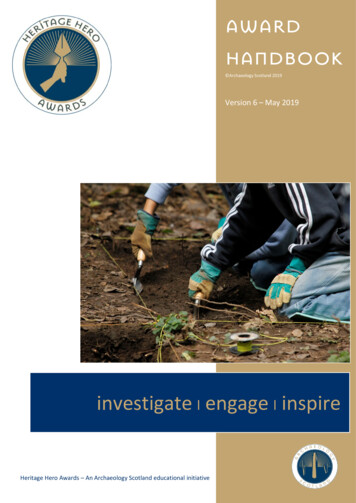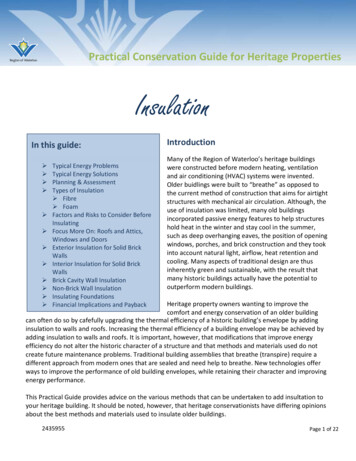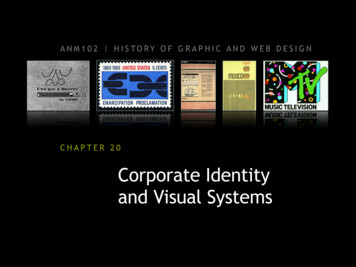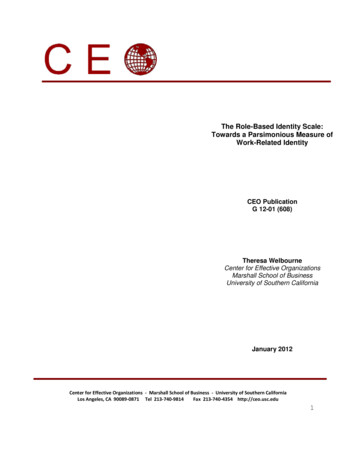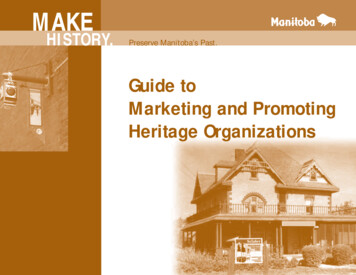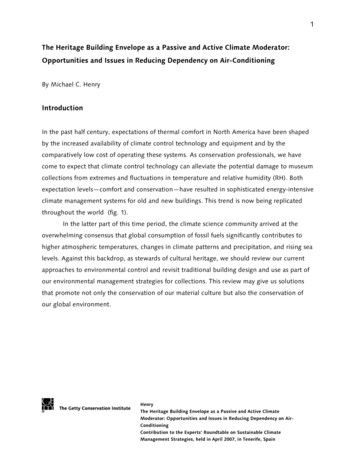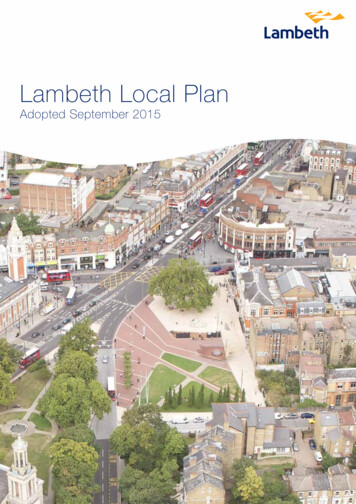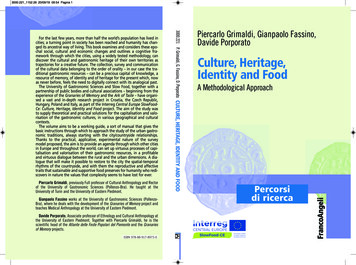
Transcription
3000.221 1152.26 20/09/19 09:54 Pagina 1Gianpaolo Fassino works at the University of Gastronomic Sciences (PollenzoBra), where he deals with the development of the Granaries of Memory project andteaches Medical Anthropology at the University of Eastern Piedmont.Davide Porporato, Associate professor of Ethnology and Cultural Anthropology atthe University of Eastern Piedmont. Together with Piercarlo Grimaldi, he is thescientific head of the Atlante delle Feste Popolari del Piemonte and the Granariesof Memory projects.Piercarlo Grimaldi, Gianpaolo Fassino,Davide PorporatoCulture, Heritage,Identity and FoodA Methodological ApproachPercorsidi ricercaFrancoAngeliPiercarlo Grimaldi, previously Full professor of Cultural Anthropology and Rectorof the University of Gastronomic Sciences (Pollenzo-Bra). He taught at theUniversity of Turin and the University of Eastern Piedmont.3000.221 P. Grimaldi, G. Fassino, D. Porporato CULTURE, HERITAGE, IDENTITY AND FOODFor the last few years, more than half the world’s population has lived incities; a turning point in society has been reached and humanity has changed its ancestral way of living. This book examines and considers these epochal social, cultural and economic changes and outlines a cognitive framework through which the cities, using a widely tested methodology, candiscover the cultural and gastronomic heritage of their own territories astrajectories for a creative future. The collection, survey and communicationof the cultural data belonging to the order of orality – in our case the traditional gastronomic resources – can be a precious capital of knowledge, aresource of memory, of identity and of heritage for the present which, nowas never before, feels the need to digitally connect with its analogical past.The University of Gastronomic Sciences and Slow Food, together with apartnership of public bodies and cultural associations – beginning from theexperience of the Granaries of Memory and the Ark of Taste – have organised a vast and in-depth research project in Croatia, the Czech Republic,Hungary, Poland and Italy, as part of the Interreg Central Europe SlowFoodCe: Culture, Heritage, Identity and Food project. The aim of the study wasto supply theoretical and practical solutions for the capitalisation and valorisation of the gastronomic cultures, in various geographical and culturalcontexts.The volume aims to be a working guide, a sort of manual that gives thebasic instructions through which to approach the study of the urban gastronomic traditions, always starting with the city/countryside relationships.Thanks to the practical, applicative, experimental nature of the surveymodel proposed, the aim is to provide an agenda through which other citiesin Europe and throughout the world, can set up virtuous processes of capitalisation and valorisation of their gastronomic resources, in a profitableand virtuous dialogue between the rural and the urban dimensions. A dialogue that will make it possible to restore to the city the spatial-temporalrhythms of the countryside, and with them the reproductive and affectivetraits that sustainable and supportive food preserves for humanity who rediscovers in nature the values that complexity seems to have lost for ever.
Percorsi di ricercaCOLLANA DIRETTA DA RENATO GRIMALDIComitato scientifico: Roberto Albera – Dipartimento di Scienze Chirurgiche (Torino),Marco Cantamessa – Dipartimento di Ingegneria Gestionale e della Produzione(Torino), Elena Cattelino – Università della Valle d’Aosta, Marco Devecchi –Dipartimento di Scienze Agrarie, Forestali e Alimentari (Torino), Vincenzo Lombardo –Dipartimento di Informatica (Torino), Sergio Margarita – Dipartimento di Management(Torino), Witold Misiuda-Rewera – Uniwersytet Marii Curie-Sklodowskiej (Lublin),Silvano Montaldo – Dipartimento di Studi Storici (Torino), Giovanni Onore –Departamento de Biologia (Quito), José Emilio Palomero Pescador – Universidad deZaragoza, Maria Margherita Satta – Dipartimento di Storia, Scienze dell’Uomo e dellaFormazione (Sassari), Roberto Trinchero – Dipartimento di Filosofia e Scienzedell’Educazione (Torino), Christopher Weiss – New York UniversityLe scienze umane e le scienze naturali sono destinate a cooperare nonostante la frattura cognitiva esistente. Questa collana, che nasce con il coinvolgimento di studiosi dei duecampi, vede nella ricerca e nell’uso delle nuove tecnologie il luogo sia fisico sia concettualeper la creazione di un insieme di modelli di relazioni di riferimento per la costruzione diteorie e per l’orientamento di scelte rilevanti in campo politico, economico, industriale, tecnologico, sanitario, educativo, ambientale, storico, sociale.Tutti i testi sono preventivamente sottoposti a referaggio anonimo.
I lettori che desiderano informarsi sui libri e le riviste da noi pubblicatipossono consultare il nostro sito Internet: www.francoangeli.it e iscriversi nella home pageal servizio “Informatemi” per ricevere via e-mail le segnalazioni delle novità.
COPY 15,5X231-02-20168:56Pagina 1Piercarlo Grimaldi, Gianpaolo Fassino,Davide PorporatoCulture, Heritage,Identity and FoodA Methodological ApproachPercorsidi ricercaFrancoAngeliForeword by Carlo Petrini
This publication has been produced with the assistance of the European Union. The contents ofthis publication are the sole responsibility of the project partners and can in no way be taken toreflect the views of the European Union.This QR Code refers to the page of The Granaries of Memory which includes all the interviewsgathered during the project.Translated by Katherine CliftonCopyright 2019 by Interreg Central Europe SlowFood-CE.Stampa: Geca Industrie Grafiche, Via Monferrato 54, 20098 San Giuliano Milanese.
ContentsForeword. The gastronomic heritage of the European cities,by Carlo Petrinip.7Introduction, by Piercarlo Grimaldi, Gianpaolo Fassino,Davide 620212223242526272832333435»»3636Food: a European culture and identitary heritage, byPiercarlo Grimaldi1. Culture and memories2. The orality of the gesture and of the word: fromanthropological urgency to oblivion3. SlowFood-CE: Culture, Heritage, Identity and Food3.1. To the east of our orient, the west of our occident3.2. Metropoles: into the countryside and back again3.3. Biodiversity and ethno- cultural diversity3.4. A manual of humanity4. The cultural pillars of the research4.1. Cultural assets and cultural heritage4.2. Narrated heritage, liberated heritage4.3. Slow Food: a case study4.4. The University of Gastronomic Sciences4.5. Food4.6. Thinking holistically5. Granaries of Memory5.1. The granaries: a digital mind to capitalise ethnoand biodiversity5.2. The memories of food5
Seeking gastronomic know-how. Ethnography in theInterreg SlowFood-CE: Culture, Heritage, Identity and Foodproject, by Gianpaolo Fassino1. From the conception to the territory: ethnography ofthe journey and the meeting2. From the library to the field: research into gastronomicheritage3. From the field to the action: the valorisation of thegastronomic heritage4. The communicative interface of the project: the eplatform Food Paths �7576Appendices1. Types of questionnaire used for the interviews1.1. Interview template – cooks/chefs1.2. Interview template – farmers/producers1.3. Interview template general2. Forms Ark of Taste2.1. Product of animal origin form2.2. Product of plant origin form2.3. Processed product form3. Interview graphySitography»»95105The authors»107Collecting gastronomic cultures, learning online. Anoperative approach for Slow Food-Central Europe, byDavide Porporato1. Introduction2. Granaries of Memory: an archive of life stories2.1. Gathering and telling stories3. The Ark of Taste: saving what can be saved4. Learner communities: the Slow Food-Central Europetraining course4.1. Structure of the training course6
ForewordThe gastronomic heritage of the European citiesby Carlo PetriniPresident of the University of Gastronomic SciencesWe are what we are and what we will be in the future partly becausepopular culture, which rarely relied on writing, has so far been able to passon from generation to generation, knowledge, poetry, and manual skills thatnow seem to be relegated to a subservient role in stable memory. Memorynow appears to be true, scientific and certified only if it is deposited on paper and stored in digital media. Mnemonics, proverbial structures and idioms have allowed humanity to conserve, elaborate and creatively reelaborate the knowledge that the past handed down, using these fragile, iterative lexical structures that only find their natural archive and their elaboration and re-elaboration in the mind.Today, the culture of traditions appears to be endangered, threatened bya world that desperately seeks to obliterate the past. To counteract this perilous drift that delegates to others the conservation and processing ofmemory, a course that is certainly not innocent since, as we used to say, itbrings both joys and sorrows, it is necessary to awaken the consciences laidto rest by a hegemonic information system that wants to design the futurefor us. It is therefore essential to collect the testimonies of the communities,in order to prevent their dispersion. Once upon a time, there was the oralmemory that guaranteed the transmission of this heritage. Today we mustconstruct ‘granaries’ in which to store against the famine of ideas, to counter the dominant mass culture that has taken away the voice of the preciousknowledge of our old people. I don’t want to leave these battles to others.We must all defend the biodiversity of cultures, restoring dignity to indigenous languages and dialects. On the other hand, saving ethnodiversitymeans actively participating in protecting biodiversity; two models of development that today appear to be of little interest and even in contrast withthe ideas of those who doltishly govern the world. They do not understandthat these two pillars of traditional critical knowledge were, until recently,7
when the countryside still provided biological and affective nourishment,experienced as a single great project of significance, a granary that provided food and that encouraged good community practices.Starting from this awareness, in 2010, the University of GastronomicSciences in Pollenzo launched the project Granaries of Memory, an ambitious research project that concerns the memory of the world, the recoveryof oral and gestural knowledge, a constitutive part of mankind’s evolutionary process (Grimaldi, 2012b; Grimaldi, Porporato, 2012). A vast programme of anthropological research that has gathered the life stories ofover a thousand peasant farmers, breeders, cheesemakers, artisans andcooks, people who in various capacities work every day to safeguard theworld’s gastronomic heritage. Over the years, the Pollenzo anthropologistshave investigated and explored the study and collection of videotestimonies concerning rural contexts, recording the voices of the farmersof the Earth, of the people of Terra Madre, of the cheesemakers who flockto Bra – my home town – every two years on the occasion of Cheese, thefishermen who animate the port of Genova during SlowFish. The studentsof the University of Pollenzo have also helped to expand this extraordinarycollection of testimonies during educational trips throughout the world,joined by other collaborative networks, starting, of course, with the globalSlowFood network, through food presidia, condotte and communities (Fassino, Porporato, 2016, pp. 187-189). Specific research projects have givenrise to themed sections aimed at documenting, particular gastronomic traditions – this is the case of the Alba white truffle (Grimaldi, 2017) and traditional Italian espresso coffee (Fassino, 2018b) – and defined geographicalareas.Among the many, I would like to mention the one dedicated to the riverPo, Alla ricerca del grande fiume, which presents the results of ethnoanthropological research conducted during the journey we made along thePo in 2007, on the fiftieth anniversary of Mario Soldati’s TV documentaries Viaggio nella valle del Po alla ricerca dei cibi genuine [exploring thePo valley in search of wholesome food] (Capatti, 2007; Grimaldi, 2012a,pp. 205-227; Petrini, 2007b; 2017, p. 265). The Laboratory ‘Granaries ofMemory’ has also built and consolidated over time significant scientific cooperation with other universities and research centres that have further enriched this archive.It was a vast and ambitious work that could not, however, be limitedto the sole – necessary and inescapable – activity of collecting and filingtestimonies on the stories of agriculture, food and gastronomy. It inevitablyincluded a more complex activity of experimentation in the field, also with8
in new geographical and social contexts, expanding and refining the theoretical and methodological framework on which it was based. The opportunity to take this further step arrived in 2017, within the framework of theInterreg Central Europe Project called SlowFood-CE: Cultures, Heritage,Identity and Food of which this volume summarises the theoretical premises and narrates the investigative and scientific principles. The University ofGastronomic Sciences, along with five major European cities, Venice, Dubrovnik, Brno, Kecskemét and Kraków, the SlowFood network and otherlocal associations and cultural organisations have conducted an innovativesurvey of the gastronomic heritage within historically, geographically andculturally diverse contexts. It was a complex project in which the investigation into ethnodiversity (a fundamental element of the Granaries ofMemory project) was combined with awareness of biodiversity, part of theArk of Taste project, which aims to survey products – fruit, vegetables, animal breeds, cheeses, breads, desserts, cold cuts, etc. – that belong to theculture, history and traditions of the entire planet. The fruitful encounterbetween these two perspectives of investigation has made it possible to undertake, in the context of the Central Europe project, an innovative investigation protocol, a theoretical and technical-methodological framework inan area still little explored as regards food and the gastronomic traditions:that of the cities.For a long time, studies on gastronomic heritage have preferentially andprimarily looked at rural contexts, the agricultural world where everythingwe eat is generated and located. In reality, a well-established historiographical tradition has amply ascertained that cities are the place where gastronomic traditions have consolidated and settled. The research conducted bymy friend Massimo Montanari and many of the other scholars who havefollowed in his footsteps have clearly shown the inseparable and inescapable relationship between city and countryside that has deeply scored theItalian gastronomic culture, becoming one of its distinctive features (Montanari, 2010, pp. 7-12; Bevilacqua, 2017, pp. 37-41). The British historianJohn Dickie remarked that «it is no coincidence that so many products ofItalian cuisine and dishes are named after cities: bistecca alla fiorentina,prosciutto di Parma, saltimbocca alla romana, pizza napoletana, risottoalla milanese, pesto genovese, pesto trapanese, olive ascolane, mostarda diCremona » (Dickie, 2007, p. 7). However, this link is not exclusive to theItalian context; it is to be found in different forms in other areas. Each cityhas generated and developed a special relationship with the culture of food.It is determined by the surrounding territory, by the history of customs, bythe creativity and savoir-faire of its citizens and by the culture and influ9
ences of the immigrant communities. Additionally, in recent years, virtuouspaths of rediscovery and enhancement of the gastronomic heritages of entire territories have started from the cities, thanks to the commitment of eminent chefs, who now pay more attention to local agricultural produce, tothe spread of the Farmer’s Markets, which made an essential contributionto renewing the sometimes frayed links between the urban and rural world,between the city and ‘its countryside’. These are just a few examples thathighlight a multifaceted, complex phenomenon that I have repeatedly witnessed, in various parts of the world, during my travels (Petrini, 2013).Analysing all these different aspects in the heart of Europe has been theambitious challenge that, for three years, has involved the many peoplewho worked on the SlowFood-CE project in the various territories. A project, I would like to emphasise, not only involving scientific investigationof the gastronomic heritage in urban contexts, but also a virtuous courseaimed at its enhancement, expressing the contemporary value of the gastronomic traditions in various fields: from education to tourism, from capitalisation to the creation of supply chains that integrate economic, environmental and social sustainability. A project that is not just research, but genuineand mature applied anthropology.One of the main objectives of the SlowFood-CE project was the creationof a study and enhancement model – that is to say, ‘a catalyst for promotion’ – that could be transferred to other urban contexts, primarily European, but also non-European. Thanks to its applicative nature, this model fittingly aims to recognise the true value of traditional food, through an understanding of the producers, plant varieties, animal breeds, traditional processing techniques, folklore and the cultural landscape, in a holistic reading, where the various elements combine to define and restore the gastronomic heritage in its cogent and complex historical-cultural unity. Thisbook presents the innovative survey model and its feasibility: a programmethat other cities in Europe and throughout the world will be able to adoptand adapt, thus enriching the knowledge of their own gastronomic heritage.I am therefore grateful to Piercarlo Grimaldi, Davide Porporato andGianpaolo Fassino for their commitment to this project, to the constructionof the theoretical and methodological model that substantiated it, and forhaving now shared it in this book.10
Introductionby Piercarlo Grimaldi, Gianpaolo Fassino, Davide PorporatoFor the last few years, more than half the world’s population has lived incities; a turning point in society has been reached and humanity haschanged its ancestral way of living. This book examines and considersthese epochal social, cultural and economic changes and outlines a cognitive framework through which the cities, using a widely tested methodology, can discover the cultural and gastronomic heritage of their own territories as trajectories for a creative future. The collection, survey and communication of the cultural data belonging to the order of orality – in our casethe traditional gastronomic resources – can be a precious capital ofknowledge, a resource of memory, of identity and of heritage for the present which, now as never before, feels the need to digitally connect with itsanalogical past.The University of Gastronomic Sciences and Slow Food, together with apartnership of public bodies and cultural associations – beginning from theexperience of the Granaries of Memory and the Ark of Taste – have organised a vast and in-depth research project in Croatia, the Czech Republic,Hungary, Poland and Italy, as part of the Interreg Central EuropeSlowFood-Ce: Culture, Heritage, Identity and Food project. The aim of thestudy was to supply theoretical and practical solutions for the capitalisationand valorisation of the gastronomic cultures, in various geographical andcultural contexts.The volume aims to be a working guide, a sort of manual that gives thebasic instructions through which to approach the study of the urban gastronomic traditions, always starting with the city/countryside relationships.Thanks to the practical, applicative, experimental nature of the surveymodel proposed, the aim is to provide an agenda through which other citiesin Europe and throughout the world, can set up virtuous processes of capitalisation and valorisation of their gastronomic resources, in a profitable11
and virtuous dialogue between the rural and the urban dimensions. A dialogue that will make it possible to restore to the city the spatial-temporalrhythms of the countryside, and with them the reproductive and affectivetraits that sustainable and supportive food preserves for humanity who rediscovers in nature the values that complexity seems to have lost for ever.In particular, the first chapter Food: a European culture and identitaryheritage, invites us to consider how the ethno-anthropological cultural heritages can become an excellent starting point for triggering good, clean andfair community practices. The text deals with key questions of the contemporary debate on topics such as the relationship between ethno- and biodiversity and the bond between city and countryside, developing specific anthropological aspects that are also the basis of the gastronomic sciences.Never before has the scientific concept of memory been of such theoreticaland methodological interest. The oppositional concepts of orality and writing have been complexified and it seems opportune to reconsider these categories in the light of the new technologies that tend to make oral thatwhich seemed the exclusive dominion of the written. In the anthropologicalfield many experiments have been carried out through the gathering, thecataloguing and the communication of cultural data that belongs to the order of orality. This heritage of knowledge becomes a resource of memory,of identity and of heritage for the contemporary world, which has an increasing need to connect technologically with the past in order to definenew trajectories of a creative future, of narrations that know how to combine the myth with the innovations born of the intelligence of the present.The second part – Seeking gastronomic know-how. Ethnography in theInterreg SlowFood-CE: Culture, Heritage, Identity and Food project –provides an understanding, through a sort of ethnography of the project, ofthe way the theoretical and methodological framework of Slow Food-CEcame about and how the fieldwork in the five urban contexts surveyed:Brno, Dubrovnik, Kecskemét, Krakow and Venice was conducted. Startingwith the analysis of the individual local environments, a shared transnational working method was established. Following the initial, challenging,phase of study and cataloguing of the urban cultural and gastronomic heritages, the project continued with the planning and organisation of goodpractices to valorise these heritages sustainable tourism, cultural events,food education, public markets, etc.). The chapter presents the basic stagesof this work: an experimental methodology of knowledge and action thatcan become – we hope – a model for the interpretation and valorisation ofthe cultural gastronomic heritages of other cities.12
The third chapter of the book, Collecting gastronomic cultures, learningonline. An operative approach for Slow Food-Central Europe, describesthe training activities that characterised the SlowFood-CE project. Based onan ongoing discussion between social actors who were working together forthe first time, within an innovative theoretical and methodological framework, this course found a key ally in multimedia and interactive technologies. The chapter illustrates the structure of the course and the principalcontent of the teaching units. In the appendices there are a series of questionnaires used in the qualitative interviews, and the surveys designed tocatalogue the gastronomic biodiversities.The book is the result of shared and communal work but the volume isdivided as follows: the author of the first chapter is by Piercarlo Grimaldi,the second by Gianpaolo Fassino, the third by Davide Porporato.AcknowledgementsWe authors owe many debts assumed during the writing of the volumeand, above all, during the research work that took place in the previousyears. Particular thanks go, undoubtedly, to the European partners whoshared with the University of Gastronomic Sciences the inspiring challenges of the Interreg project SlowFood-CE: Culture, Heritage, Identity andFood. A wide-ranging and complex partnership, formed of representativesof public bodies and the community. In recalling the names of the partnerinstitutions and associations we wish to mention also and above all the organisational, cultural and affective intelligence of the individual people involved – it is impossible to list them all here – who, in the various cities,accompanied us in the project and shared and experimented the workingmethod established: in Croatia, the City of Dubrovnik Development Agency and Kinookus Association, in The Czech Republic, the Tourist Authority South Moravia and Slow Food Brno, in Hungary, the Municipality ofKecskemét and Kiskunság Tradition-bound, Artisans and Tourism Association, in Poland, the Municipality of Krakow and, although only for the firstyear of the project, Slow Food Poland. As Italians, allow us to emphasisethat the opportunity of working with the City of Venezia – ‘the pearl of Italy’ – was not merely a profitable occasion for study and research, but alsoan honour and a particular pleasure.The associate partners also offered precious support for the collectivework: City of Dubrovnik, Ston Tourist Board, City of Brno, MałopolskaTourism Organisation, Academy of Physical Education and Tourism in13
Krakow (Tourism and Leisure Faculty), European Institute for the Historyand Cultures of Food, Europa Nostra.Slow Food – represented in particular by Paola Roveglia, Serena Alaimo and Elisa Peirone – was once again an essential travelling companion inthis adventure of awareness and understanding. Raffaella Ponzio, Alice Pettenò and Michela Lenta contributed significantly to the setting up of thework method, starting with the Ark of Taste experience. The entire structureof the University of Gastronomic Sciences accompanied with professionalism the development of the SlowFood-CE project: we own an informalthank you to the director Stefania Ribotta, to Chiara Monge, Serena Rinaldiand Maurizio Tomalino, who followed us step by step in the complex management that always accompanies these vast and multifaceted internationalprojects. At the Unisg Laboratory Granaries of Memory the work of LucaGhiardo and Luca Percivalle was precious.The president of the University of Gastronomic Sciences, Carlo Petrini,shared our belief that it was necessary to use scientific methods to surveythe gastronomic heritages of the cities of our beloved Europe – as witnessed by the foreword to the book that he has offered – he gave precioussupport not only to the authors, but to the entire SlowFood-CE partnership.After all, the name itself of this project shows how the work and the ideasof Carlo Petrini were the seed from which this research bloomed: and forthis, we thank him.14
Food: a European culture and identitary heritageby Piercarlo Grimaldi1. Culture and memoriesThe concept of memory is one of the scientific categories that, morethan any other, has traversed the numerous academic fields to become a keydisciplinary sector1. A topic that is now facing an important change of direction in the evolutionary journey of humanity, coinciding with the disappearance of memory based on orally transmitted knowledge in favour of thewritten and the digital. A difficult moment of transition that requires astrong, demanding and pondered commitment in order to glean what remains of the past and understand how we can use it in the new, reinventedcourse of memory. A process now based on stable knowledge props thatdefine and change the immutability and, at the same time, on the transienceof oral knowledge, proposing interpretations not yet fully understood thatpertain to new forms and practices of historicity of data. Then again, inventing tradition is a concept on which much work has been done and thathas opened up interesting processes of knowledge (Hobsbawm, Ranger,1983).New advanced models of storage, elaboration, transmission and communication of memory abound. While on the one hand, at first glance, theyseem to offer scientific solutions of memories that challenge time, on theother, the externalisation of the oral memory based on information thatflows from one generation to another, seems to dispense with excessivelynaïve certainty a heritage that allowed us to be who we were. The artificialnature of the digital technology underlies this memory project and seems tobecome a heritage that no longer belongs to the individual, but to a technological programme that hands over to politics and to the global powers that1Some of the considerations in this chapter derive from texts, discussion materials andwork elaborated during the recent years of my study and research activities.15
possess the new technologies needed to store and critically control the information, a knowledge that is either collective, or is not. A decisive stageof sharing on the web, of multimedia virtual social relationships, a new wayof interpreting knowledge that can also foster a desirable willingness toconsider a holistic framework, a theoretical and methodological agenda thatallows us to critically examine the topic through different approaches, in anorganic, systemic and transdisciplinary way. A method that allows us to define, through the joint contribution of the single disciplines, a means ofreaching new, creative and original, interconnected knowledge.Memory is a keystone of the construction of time and place. It is a constitutive part of the rhythms that define the evolutionary process of man andof his becoming humanity (Leroi-Gourhan, 1964-1965). It is also the themethat underlies the research that follows, because it is wi
Percorsi di ricerca F r a n c o A n g e l i For the last few years, more than half the world's population has lived in cities; a turning point in society has been reached and humanity has chan -

